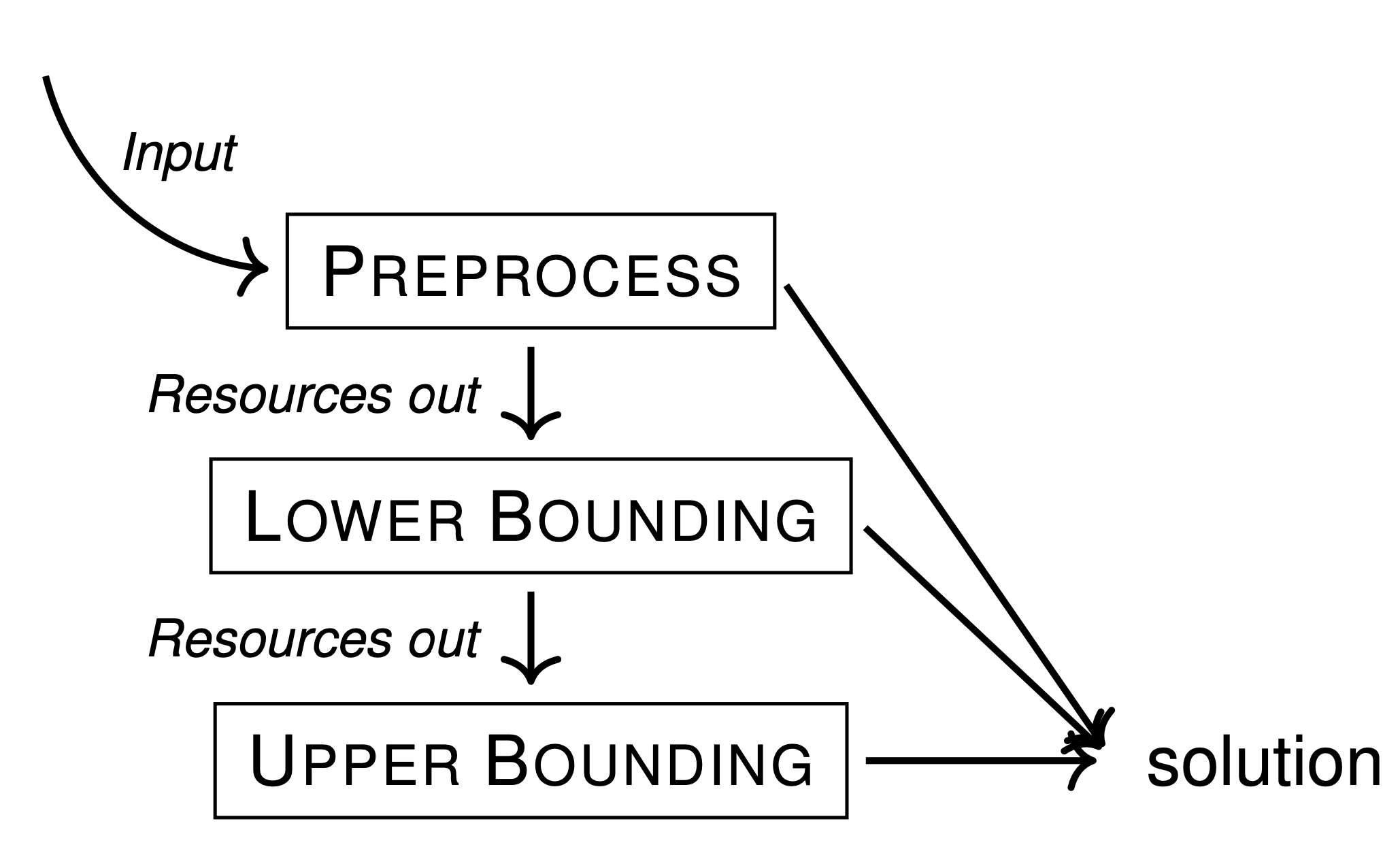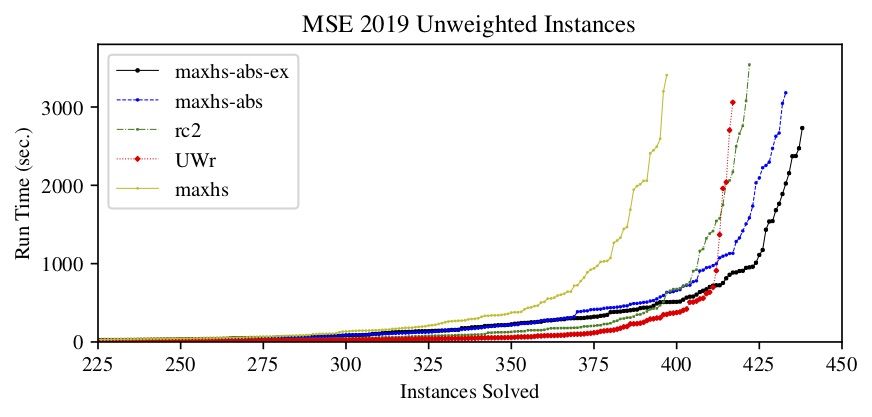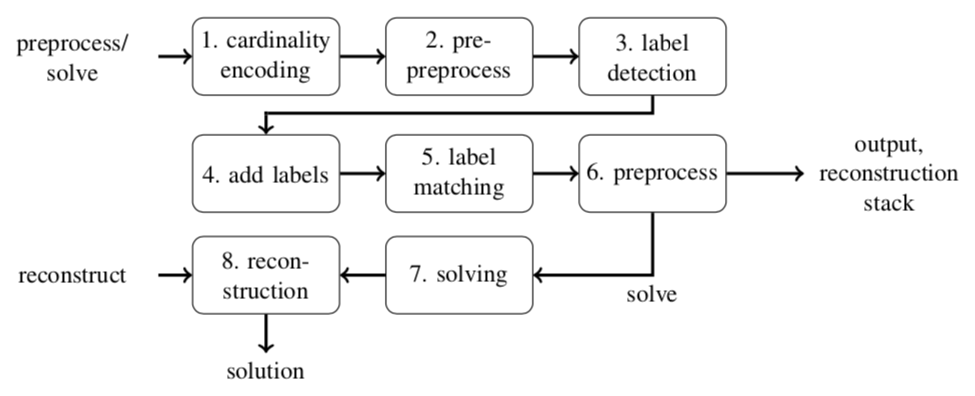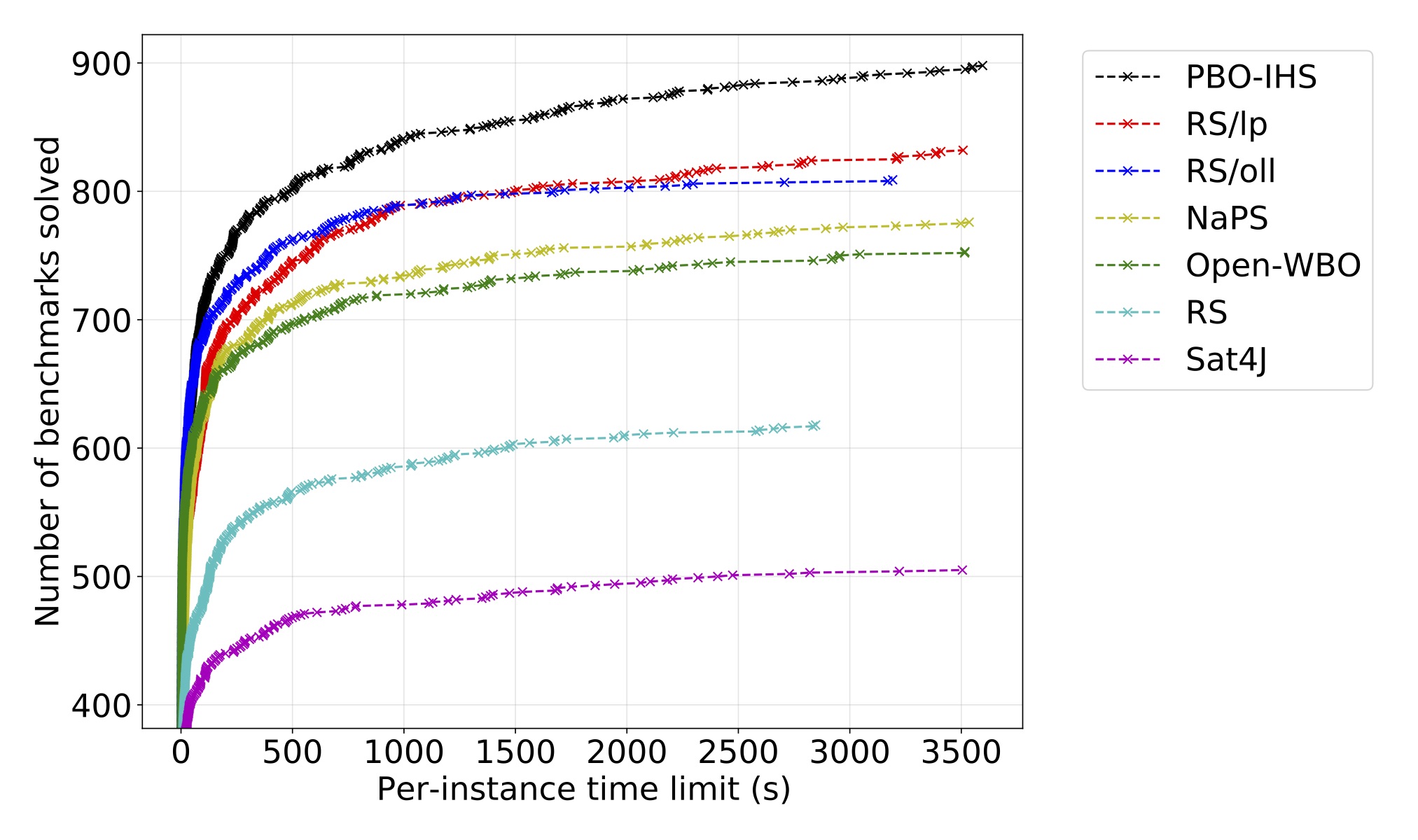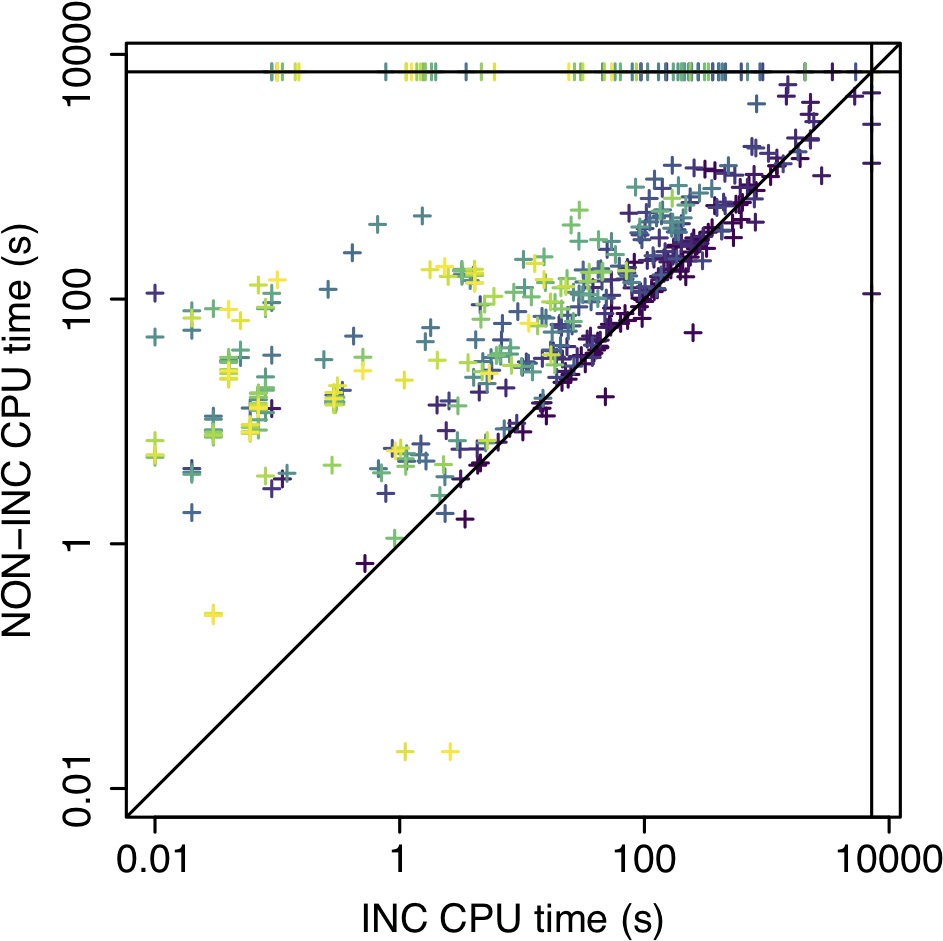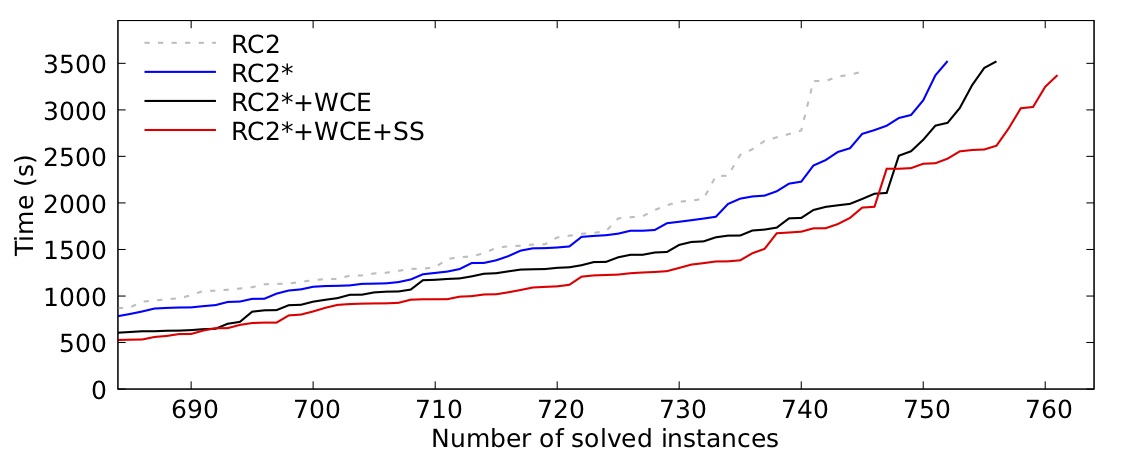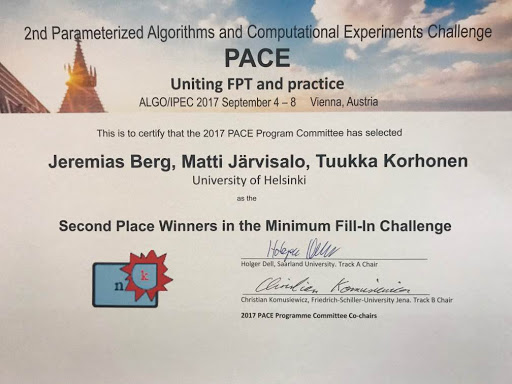software
research software I have contributed to. If you use them in your work please cite the given references.
Loandra - Core-Boosted Linear Search
Loandra is an any-time MaxsAT solver that implements the so called core-boosted search algorithm that we developed during my visit to Melbourne in 2018. Core-boosted search is a two stage search strategy that starts of in a core-guided (lower bounding) phase and then switches to a linear (upper bounding) phase. Loandra performed very well in the 2019 MaxSAT Evaluation, placing first and second in the unweighted and weighted incomplete tracks, respectively. The algorithmic ideas underlying Loandra have also been implemented in pseudo-Boolean optimization, and constraint programming.
In 2021 Loandra with added preprocessing again did very well, taking first in the weighted 300s category and 4th in all others.
Loandra is mainly developed by me, the source code can be found on github. Loandra owns much of its existence to the developers of Open WBO. I’d like to thank them for their hard work.
Abstract Cores - in Implicit Hitting Set-based MaxSAT
During my visit to Toronto in 2019. We worked on extending the implicit hitting set (IHS) algorithm for MaxSAT with abstract cores. Abstract cores which can be seen as a hybridization between core-guided and hitting set-based algorithms, as well as symmetry breaking. The work was recognized with a paper award at the 2020 SAT conferece, the flagship conference of the research field of Boolean satisfiability.
We show how adding abstract cores into the MaxSAT solver MaxHS significantly improves its performance. The solver took top positions in the 2020 and 2021 MaxSAT Evaluations. More recently, we have shown how abstract cores can be used as a basis for a framework that unifies most of the existing SAT-based MaxSAT algorithms.
MaxHS is available on the MaxSAT Evaluations webpage.
MaxPre - Preprocessing for Maximum Satisfiability
MaxPRE is a preprocessor capable of simplifying single-, and multiobjective MaxSAT instances in a cost-preserving manner. MaxPre imnplements a wide-range of different simplification rules, including MaxSAT-liftings of preprocessing rules commonly used in SAT solving (BVE, SE; SCE, BVA etc.) as well as MaxSAT-specific preprocessing rules that we have developed in our group.
MaxPre implements a multitude of the algorithmic techniques proposed by me during my PhD research and after it. MaxPre can be used either as stand-alone, or through an API that allows tight integration with your solver. The first version of MaxPRE was developed by Tuukka Korhonen, The source code of that version is available in open-source on github.
The second version of MaxPRE, dubbed MaxPre 2.0 is currently developed by Hannes Ihalainen. It is available in open-source on bitbucket. Compared to the first version, MaxPre 2.0 includes a number of quality of life improvements and extended reasoning techniques.
PBO-IHS - Pseudo-Boolean Optimization via Implicit Hitting Sets
PBO-IHS is an implementation of the implicit hitting set approach to pseudo-Boolean optimization. PBO-IHS uses the conflict-driven pseudo-Boolean solver RoundingSAT as a core-extractor and the CPLEX mixed-integer programming solver as a hitting-set solver. We have shown that PBO-IHS achieves orthogonal performance compared to other state-of-the-art PBO-solvers and currently represents one of the best performing approaches to PBO.
PBO-IHS was developed by Pavel Smirnov. It is available in open source (as long as you supply your own MIP solver) on bitbucket
Scuttle & BiOptSAT - Multi-Objective MaxSAT
Scuttle and BiOptSAT are two solvers for multiobjective MaxSAT developed in out group. Both solvers compute the so-called pareto-optimal solutions of multiopbjective MaxSAT isntances. BiOptSAT is an efficient implementation of the so-called lexicographic method for bi-objective problems, first proposed for MaxSAT by our group. Scuttle implements a number of other algorithms first proposed by other groups, including the so called P-minimal algorithm, and a lower-bounding core-guided algorithm.
Both solvers have been mainly developed by my PhD student Christoph Jabs who wrote his M.Sc. thesis on BiOptSAT.
IMaxHS - Incremental Optimization with Hitting Sets
IMaxHS is an incremental version of the MaxHS solver that implements the implicit hitting set approach to MaxSAT. IMaxHS is tailored toward applications that require solving a sequence of optimization problems. By maintaining its internal state we demonstrate that IMaxHS can e.g. learn interpretable classifiers much more efifciently compared to the naive approach of restaring search from scratch on each iteration.
iMaxHS is primarly developed by Andreas Niskanen.
CGSS - A Core-Guided MaxSAT solver
CGSS is an effective implementation of the OLL algorithm for MaxSAT. The first version of CGSS was built on top of the RC2 MaxSAT solver in Python. The current–and much more effective–version is a reimplementation from scratch in C++. Most notably, CGSS extends RC2 with the so called structure sharing (SS) technique that results in more compact encodings of the constraints required for optimization. More details can be found in (Ihalainen et al., 2021).
CGSS is developed by my PhD student Hannes Ihalainen who wrote his M.Sc. thesis on it. The implementation is available in open source on bitbucket. The first (Python) version of CGSS was further extended with proof logging in 2023 by Andy Oertel. The source code of the proof-logging version can be found on gitlab
Triangulator - Potential Maximal Cliques for Graph Parameters
Triangulator is an implementation of the Bouchitté-Todinca algorithm for finding minimal graph triangulations that are optimal with respect to different cost function. The approach can be used to solve many different graph-related problems. More precisely, Triangulator can be used for computing the treewidth and minimum fill-in of a graph, the generalized hypertreewidth and fractional hypertreewidth of a hypergraph or the total table size of a Bayesian network. Triangulator placed second in the minimum-fill in track of the 2017 PACE challenge.
Triangulator is developed by Tuukka Korhonen. It is available in open-source on GitHub.
